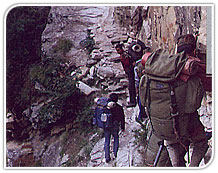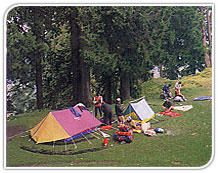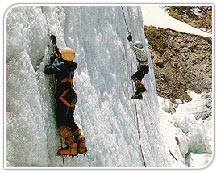Mountaineering In India
 If
you're fired by the spirit of adventure, let the sparks in your heart
fly...... in India, a land blessed with lofty snow-clad peaks, crystal
glaciers, rolling meadows, jagged rock faces, verdant valleys, meandering
rivers, cascading waterfalls, dense forests, and hospitable people,
blessed with a rich culture - a land perfect for mountaineering, trekking,
and rock climbing.
If
you're fired by the spirit of adventure, let the sparks in your heart
fly...... in India, a land blessed with lofty snow-clad peaks, crystal
glaciers, rolling meadows, jagged rock faces, verdant valleys, meandering
rivers, cascading waterfalls, dense forests, and hospitable people,
blessed with a rich culture - a land perfect for mountaineering, trekking,
and rock climbing.
Seasons:
While the mountaineering
season tends to be concentrated around the April-November period, a number
of climbs are also attempted in winter (December-March) which, though much
colder, allows for clearer climbing days.
Categories:
Mountaineering
routes are graded, according to the degree of difficulty and
accessibility. Prior medical examination is essential. The permanent
snowline, generally being in the region of 5,200 m, the degree of
difficulty of mountaineering routes, can broadly be defined as :
Moderate:
 Requiring
knowledge of basic mountaineering techniques, such as those imparted by
the Nehru Institute of Mountaineering at Uttarkashi, the Himalayan
Mountaineering Institute at Darjeeling, and the Western Himalayan
Institute of Mountaineering at Manali.
Requiring
knowledge of basic mountaineering techniques, such as those imparted by
the Nehru Institute of Mountaineering at Uttarkashi, the Himalayan
Mountaineering Institute at Darjeeling, and the Western Himalayan
Institute of Mountaineering at Manali.
Advanced:
For
this category of peaks, it is necessary to be in top physical condition,
and to possess advanced mountaineering skills, either through the advanced
courses of mountaineering institutes, or through expedition experience.
Within this category, further demarcation is possible, till the highest
degrees of difficulty.
Locales:
The main
mountaineering locales, are in the Garhwal and Kumaon regions of Uttar
Pradesh. In Garhwal, the areas, include the Tons-Banderpunch region, the
Gangotri glacier system, the Nanda Devi sanctuary (presently closed), Arwa
glacier area, Kamet and Abi Gamin. The roadheads for these at Taluka,
Gangotri, Joshimath, and Malari, can be reached in two or three days from
Delhi. In Kumaon, the areas include the Kalabaland glacier system, the
Panch Chulhi, Rajrambha, and Chaudhara peaks, and the peaks of the
Nandakot basin, on the eastern flank of the Nanda Devi sanctuary.
Equipment:
 Equipment
can be hired, either from clubs, or purchased from one of the agencies
selling it. Prior to setting out, all equipment must be tested, and team
members must familiarize themselves with its use. Kerosene must be
carried, so that the fragile mountain environment is not further degraded,
by cutting any wood. The Garhwal Mandal Vikas Nigam has a full-fledged
mountaineering and trekking division, based at Muni-ki-Reti, Rishikesh
Equipment
can be hired, either from clubs, or purchased from one of the agencies
selling it. Prior to setting out, all equipment must be tested, and team
members must familiarize themselves with its use. Kerosene must be
carried, so that the fragile mountain environment is not further degraded,
by cutting any wood. The Garhwal Mandal Vikas Nigam has a full-fledged
mountaineering and trekking division, based at Muni-ki-Reti, Rishikesh
Permits:
For
information about Peak booking fees, Inner Line restrictions, import of
equipment, camera permits, insurance, medical attention, and evacuation
procedures, contact the Indian Mountaineering Foundation based at Delhi.
This is the national apex coordinating body for the sport in India
Important:
All
expeditions, whether Indian, foreign, or joint, are required to apply to
the IMF, at least six months prior to departure, so that all the
formalities are completed within the time frame. Leaders of returning
expeditions, are required to submit reports, and adequate proof of the
climbs, to the IMF. While Indian nationals and IMF sponsored joint
expeditions, can attempt peaks beyond the 'Inner Line', foreign nationals
are as a rule not permitted to do so. Additionally, all expeditions by
foreign nationals, are required to be accompanied by an Indian liaison
officer at their cost.
The Indian Mountaineering Foundation
(IMF),
Benito Juarez Road, Anand Niketan,
New Delhi - 110021
Tel: 671211, 602245, 6883412
Fax: 91-011-6883412
OR,
Please Click Here to Contact Travel Service Providers for your
Adventure Tours in India
 If
you're fired by the spirit of adventure, let the sparks in your heart
fly...... in India, a land blessed with lofty snow-clad peaks, crystal
glaciers, rolling meadows, jagged rock faces, verdant valleys, meandering
rivers, cascading waterfalls, dense forests, and hospitable people,
blessed with a rich culture - a land perfect for mountaineering, trekking,
and rock climbing.
If
you're fired by the spirit of adventure, let the sparks in your heart
fly...... in India, a land blessed with lofty snow-clad peaks, crystal
glaciers, rolling meadows, jagged rock faces, verdant valleys, meandering
rivers, cascading waterfalls, dense forests, and hospitable people,
blessed with a rich culture - a land perfect for mountaineering, trekking,
and rock climbing.  Requiring
knowledge of basic mountaineering techniques, such as those imparted by
the Nehru Institute of Mountaineering at Uttarkashi, the Himalayan
Mountaineering Institute at Darjeeling, and the Western Himalayan
Institute of Mountaineering at Manali.
Requiring
knowledge of basic mountaineering techniques, such as those imparted by
the Nehru Institute of Mountaineering at Uttarkashi, the Himalayan
Mountaineering Institute at Darjeeling, and the Western Himalayan
Institute of Mountaineering at Manali. Equipment
can be hired, either from clubs, or purchased from one of the agencies
selling it. Prior to setting out, all equipment must be tested, and team
members must familiarize themselves with its use. Kerosene must be
carried, so that the fragile mountain environment is not further degraded,
by cutting any wood. The Garhwal Mandal Vikas Nigam has a full-fledged
mountaineering and trekking division, based at Muni-ki-Reti, Rishikesh
Equipment
can be hired, either from clubs, or purchased from one of the agencies
selling it. Prior to setting out, all equipment must be tested, and team
members must familiarize themselves with its use. Kerosene must be
carried, so that the fragile mountain environment is not further degraded,
by cutting any wood. The Garhwal Mandal Vikas Nigam has a full-fledged
mountaineering and trekking division, based at Muni-ki-Reti, Rishikesh